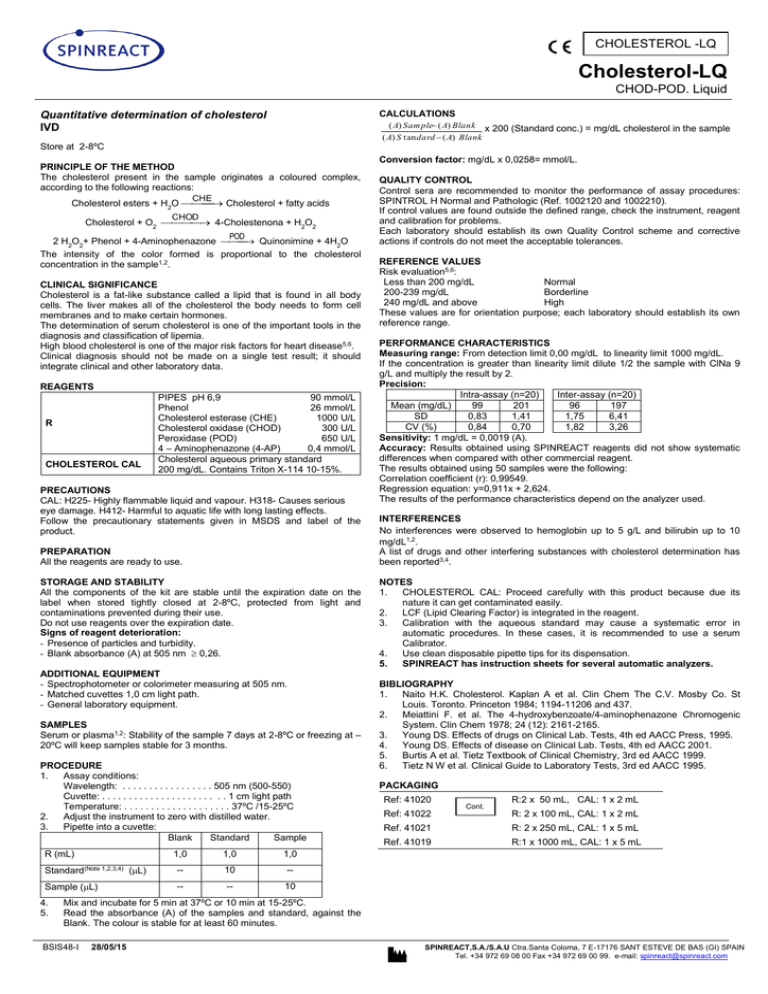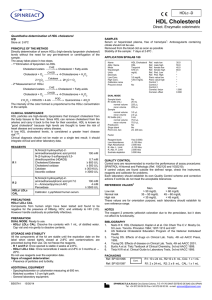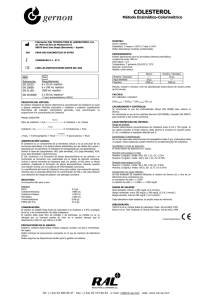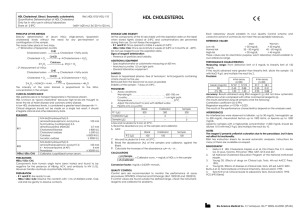Cholesterol-LQ
Anuncio

CHOLESTEROL -LQ Cholesterol-LQ CHOD-POD. Liquid CALCULATIONS Quantitative determination of cholesterol IVD ( A) Sam ple ( A) Blank x 200 (Standard conc.) = mg/dL cholesterol in the sample ( A) S t an dard ( A) Blank Store at 2-8ºC PRINCIPLE OF THE METHOD The cholesterol present in the sample originates a coloured complex, according to the following reactions: CHE Cholesterol esters + H2O Cholesterol + fatty acids CHOD Cholesterol + O2 4-Cholestenona + H2O2 POD 2 H2O2+ Phenol + 4-Aminophenazone Quinonimine + 4H2O The intensity of the color formed is proportional to the cholesterol concentration in the sample1,2. CLINICAL SIGNIFICANCE Cholesterol is a fat-like substance called a lipid that is found in all body cells. The liver makes all of the cholesterol the body needs to form cell membranes and to make certain hormones. The determination of serum cholesterol is one of the important tools in the diagnosis and classification of lipemia. High blood cholesterol is one of the major risk factors for heart disease5,6. Clinical diagnosis should not be made on a single test result; it should integrate clinical and other laboratory data. REAGENTS R CHOLESTEROL CAL PIPES pH 6,9 90 mmol/L Phenol 26 mmol/L Cholesterol esterase (CHE) 1000 U/L Cholesterol oxidase (CHOD) 300 U/L Peroxidase (POD) 650 U/L 4 – Aminophenazone (4-AP) 0,4 mmol/L Cholesterol aqueous primary standard 200 mg/dL. Contains Triton X-114 10-15%. PRECAUTIONS CAL: H225- Highly flammable liquid and vapour. H318- Causes serious eye damage. H412- Harmful to aquatic life with long lasting effects. Follow the precautionary statements given in MSDS and label of the product. PREPARATION All the reagents are ready to use. STORAGE AND STABILITY All the components of the kit are stable until the expiration date on the label when stored tightly closed at 2-8ºC, protected from light and contaminations prevented during their use. Do not use reagents over the expiration date. Signs of reagent deterioration: - Presence of particles and turbidity. - Blank absorbance (A) at 505 nm 0,26. ADDITIONAL EQUIPMENT - Spectrophotometer or colorimeter measuring at 505 nm. - Matched cuvettes 1,0 cm light path. - General laboratory equipment. SAMPLES Serum or plasma1,2: Stability of the sample 7 days at 2-8ºC or freezing at – 20ºC will keep samples stable for 3 months. PROCEDURE 1. Assay conditions: Wavelength: . . . . . . . . . . . . . . . . . 505 nm (500-550) Cuvette: . . . . . . . . . . . . . . . . . . . . . . . 1 cm light path Temperature: . . . . . . . . . . . . . . . . . . . . 37ºC /15-25ºC 2. Adjust the instrument to zero with distilled water. 3. Pipette into a cuvette: Blank Standard Sample R (mL) 1,0 1,0 Standard(Note 1,2,3,4) (L) -- 10 -- Sample (L) -- -- 10 4. 5. Conversion factor: mg/dL x 0,0258= mmol/L. QUALITY CONTROL Control sera are recommended to monitor the performance of assay procedures: SPINTROL H Normal and Pathologic (Ref. 1002120 and 1002210). If control values are found outside the defined range, check the instrument, reagent and calibration for problems. Each laboratory should establish its own Quality Control scheme and corrective actions if controls do not meet the acceptable tolerances. REFERENCE VALUES Risk evaluation5,6: Less than 200 mg/dL Normal 200-239 mg/dL Borderline 240 mg/dL and above High These values are for orientation purpose; each laboratory should establish its own reference range. PERFORMANCE CHARACTERISTICS Measuring range: From detection limit 0,00 mg/dL to linearity limit 1000 mg/dL. If the concentration is greater than linearity limit dilute 1/2 the sample with ClNa 9 g/L and multiply the result by 2. Precision: Intra-assay (n=20) Inter-assay (n=20) Mean (mg/dL) 99 201 96 197 SD 0,83 1,41 1,75 6,41 CV (%) 0,84 0,70 1,82 3,26 Sensitivity: 1 mg/dL = 0,0019 (A). Accuracy: Results obtained using SPINREACT reagents did not show systematic differences when compared with other commercial reagent. The results obtained using 50 samples were the following: Correlation coefficient (r): 0,99549. Regression equation: y=0,911x + 2,624. The results of the performance characteristics depend on the analyzer used. INTERFERENCES No interferences were observed to hemoglobin up to 5 g/L and bilirubin up to 10 mg/dL1,2. A list of drugs and other interfering substances with cholesterol determination has been reported3,4. NOTES 1. CHOLESTEROL CAL: Proceed carefully with this product because due its nature it can get contaminated easily. 2. LCF (Lipid Clearing Factor) is integrated in the reagent. 3. Calibration with the aqueous standard may cause a systematic error in automatic procedures. In these cases, it is recommended to use a serum Calibrator. 4. Use clean disposable pipette tips for its dispensation. 5. SPINREACT has instruction sheets for several automatic analyzers. BIBLIOGRAPHY 1. Naito H.K. Cholesterol. Kaplan A et al. Clin Chem The C.V. Mosby Co. St Louis. Toronto. Princeton 1984; 1194-11206 and 437. 2. Meiattini F. et al. The 4-hydroxybenzoate/4-aminophenazone Chromogenic System. Clin Chem 1978; 24 (12): 2161-2165. 3. Young DS. Effects of drugs on Clinical Lab. Tests, 4th ed AACC Press, 1995. 4. Young DS. Effects of disease on Clinical Lab. Tests, 4th ed AACC 2001. 5. Burtis A et al. Tietz Textbook of Clinical Chemistry, 3rd ed AACC 1999. 6. Tietz N W et al. Clinical Guide to Laboratory Tests, 3rd ed AACC 1995. PACKAGING Ref: 41020 Ref: 41022 Cont. . R:2 x 50 mL, CAL: 1 x 2 mL R: 2 x 100 mL, CAL: 1 x 2 mL Ref. 41021 R: 2 x 250 mL, CAL: 1 x 5 mL Ref. 41019 R:1 x 1000 mL, CAL: 1 x 5 mL 1,0 Mix and incubate for 5 min at 37ºC or 10 min at 15-25ºC. Read the absorbance (A) of the samples and standard, against the Blank. The colour is stable for at least 60 minutes. BSIS48-I 28/05/15 SPINREACT,S.A./S.A.U Ctra.Santa Coloma, 7 E-17176 SANT ESTEVE DE BAS (GI) SPAIN Tel. +34 972 69 08 00 Fax +34 972 69 00 99. e-mail: [email protected] CHOLESTEROL -LQ Colesterol-LQ CHOD-POD. Líquido CÁLCULOS Determinación cuantitativa de colesterol IVD ( A) Muestra ( A) Blanco x 200 (Conc. Patrón) = mg/dL de colesterol en la ( A) Patrón ( A) Blanco Conservar a 2-8ºC muestra PRINCIPIO DEL MÉTODO El colesterol presente en la muestra origina un compuesto coloreado según la reacción siguiente: CHE Ésteres colesterol + H2O Colesterol + Ácidos grasos CHOD Colesterol + O2 4-Colestenona + H2O2 POD 2 H2O2 +Fenol + 4-Aminofenazona Quinonimina + 4H2O La intensidad del color formado es proporcional a la concentración de colesterol presente en la muestra ensayada1,2. SIGNIFICADO CLÍNICO El colesterol es una sustancia grasa presente en todas las células del organismo. El hígado produce naturalmente todo el colesterol que necesita para formar las membranas celulares y producir ciertas hormonas. La determinación del colesterol es una de las herramientas más importantes para el diagnóstico y clasificación de las lipemias. El aumento del nivel de colesterol es uno de los principales factores de riesgo cardiovascular5,6. El diagnóstico clínico debe realizarse teniendo en cuenta todos los datos clínicos y de laboratorio. REACTIVOS PIPES pH 6,9 Fenol Colesterol esterasa (CHE) Colesterol oxidasa (CHOD) Peroxidasa (POD) 4 - Aminofenazona (4-AF) R COLESTEROL CAL 90 mmol/L 26 mmol/L 1000 U/L 300 U/L 650 U/L 0,4 mmol/L Factor de conversión: mg/dL x 0,0258= mmol/L. CONTROL DE CALIDAD Es conveniente analizar junto con las muestras sueros control valorados:SPINTROL H Normal y Patológico (Ref. 1002120 y 1002210). Si los valores hallados se encuentran fuera del rango de tolerancia, se debe revisar los instrumentos, los reactivos y la calibración. Cada laboratorio debe disponer su propio Control de Calidad y establecer correcciones en el caso de que los controles no cumplan con las tolerancias. VALORES DE REFERENCIA Evaluación del riesgo5,6: Menos de 200 mg/dL Normal 200-239 mg/dL Moderado 240 mg/dL o más Alto Estos valores son orientativos. Es recomendable que cada laboratorio establezca sus propios valores de referencia. CARACTERÍSTICAS DEL MÉTODO Rango de medida: Desde el límite de detección 0,00 mg/dL hasta el límite de linealidad 1000 mg/dL. Si la concentración de la muestra es superior al límite de linealidad, diluir 1/2 con ClNa 9 g/L y multiplicar el resultado final por 2. Precisión: Intraserie (n=20) Ínterserie (n=20) Media (mg/dL) 99 201 96 197 SD (mg/dL) 0,83 1,41 1,75 6,41 CV (%) 0,84 0,70 1,82 3,26 Patrón primario acuoso de Colesterol 200 mg/dL. Contiene Triton X-114 10-15% Sensibilidad analítica: 1 mg/dL = 0,0019 (A). Exactitud: Los reactivos SPINREACT no muestran diferencias sistemáticas significativas cuando se comparan con otros reactivos comerciales. Los resultados obtenidos con 50 muestras fueron los siguientes: PRECAUCIONES CAL: H225- Líquido y vapores muy inflamables. H318- Provoca lesiones Coeficiente de correlación (r): 0,99549. oculares graves. H412- Nocivo para los organismos acuáticos, con efectos Ecuación de la recta de regresión: y=0,911x + 2,624. Las características del método pueden variar según el analizador utilizado. nocivos duraderos. Seguir los consejos de prudencia indicados en la FDS y etiqueta del producto. PREPARACIÓN Todos los reactivos están listos para su uso. CONSERVACIÓN Y ESTABILIDAD Todos los componentes del kit son estables hasta la fecha de caducidad indicada en la etiqueta del vial, cuando se mantienen los viales bien cerrados a 2-8ºC, protegidos de la luz y se evita su contaminación. No usar reactivos fuera de la fecha indicada. Indicadores de deterioro de los reactivos: - Presencia de partículas y turbidez. - Absorbancias (A) del Blanco a 505 nm 0,26. MATERIAL ADICIONAL - Espectrofotómetro o analizador para lecturas a 505 nm. - Cubetas de 1,0 cm de paso de luz. - Equipamiento habitual de laboratorio. MUESTRAS Suero o plasma1,2. Estabilidad de la muestra 7 días a 2-8ºC y 3 meses si se mantiene la muestra congelada (-20ºC). PROCEDIMIENTO 1. Condiciones del ensayo: Longitud de onda: . . . . . . . . . . . . . . . 505 nm (500-550) Cubeta:. . . . . . . . . . . . . . . . . . . . . . . . . 1 cm paso de luz Temperatura: . . . . . . . . . . . . . . . . . . . . . . 37ºC /15-25ºC 2. Ajustar el espectrofotómetro a cero frente a agua destilada. 3. Pipetear en una cubeta: Blanco Patrón Muestra R (mL) 1,0 1,0 1,0 Patrón (Nota1,2,3,4) -10 -(L) --10 Muestra (L) 4. 5. INTERFERENCIAS No se han observado interferencias de hemoglobina hasta 5 g/L y bilirrubina hasta 10 mg/dL1,2. Se han descrito varias drogas y otras substancias que interfieren en la determinación del colesterol3,4. NOTAS 1. CHOLESTEROL CAL: Debido a la naturaleza del producto, es aconsejable tratarlo con sumo cuidado ya que se puede contaminar con facilidad. 2. LCF(Lipid Clearing Factor) está integrado en el reactivo. 3. La calibración con el Patrón acuoso puede dar lugar a errores sistemáticos en métodos automáticos. En este caso, se recomienda utilizar calibradores séricos. 4. Usar puntas de pipeta desechables limpias para su dispensación. 5. SPINREACT dispone de instrucciones detalladas para la aplicación de este reactivo en distintos analizadores. BIBLIOGRAFÍA 1. Naito H.K. Cholesterol. Kaplan A et al. Clin Chem The C.V. Mosby Co. St Louis. Toronto. Princeton 1984; 1194-11206 and 437. 2. Meiattini F. et al. The 4-hydroxybenzoate/4-aminophenazone Chromogenic System. Clin Chem 1978; 24 (12): 2161-2165. 3. Young DS. Effects of drugs on Clinical Lab. Tests, 4th ed AACC Press, 1995. 4. Young DS. Effects of disease on Clinical Lab. Tests, 4th ed AACC 2001. 5. Burtis A et al. Tietz Textbook of Clinical Chemistry, 3rd ed AACC 1999. 6. Tietz N W et al. Clinical Guide to Laboratory Tests, 3rd ed AACC 1995. PRESENTACIÓN Ref: 41020 Ref: 41022 Cont. . R:2 x 50 mL, CAL: 1 x 2 mL R: 2 x 100 mL, CAL: 1 x 2 mL Ref. 41021 R: 2 x 250 mL, CAL: 1 x 5 mL Ref. 41019 R:1 x 1000 mL, CAL: 1 x 5 mL Mezclar e incubar 5 min a 37ºC ó 10 min a 15-25ºC. Leer la absorbancia (A) del patrón y la muestra, frente al Blanco de reactivo. El color es estable como mínimo 60 minutos. BSIS48-E 28/05/15 SPINREACT, S.A/S.A.U Ctra.Santa Coloma, 7 E-171716 SANT ESTEVE DE BAS (GI) SPAIN Tel. +34 972 69 08 00 Fax +34 972 69 00 99. e-mail: [email protected]


